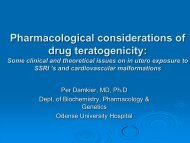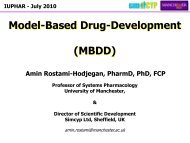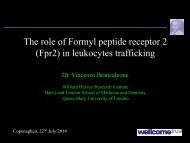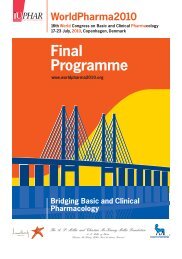Allosteric Modulators of mGluRs for Treatment of CNS Disorders
Allosteric Modulators of mGluRs for Treatment of CNS Disorders
Allosteric Modulators of mGluRs for Treatment of CNS Disorders
- No tags were found...
You also want an ePaper? Increase the reach of your titles
YUMPU automatically turns print PDFs into web optimized ePapers that Google loves.
<strong>Allosteric</strong> <strong>Modulators</strong> <strong>of</strong> <strong>mGluRs</strong> <strong>for</strong> <strong>Treatment</strong> <strong>of</strong><strong>CNS</strong> <strong>Disorders</strong>P. Jeffrey ConnDepartment <strong>of</strong> PharmacologyVanderbilt Program in Drug DiscoveryVanderbilt University School <strong>of</strong> MedicineNashville, Tennessee USA
Effects <strong>of</strong> Parkinson’s Disease on Basal GangliaNormal ParkinsonismCORTEXCORTEXSTRIATUMD 2 D 1SNcSTRIATUMD 2 D 1SNcxGPeThalGPeThalSTNSTNExcitatoryInhibitoryGPi/SNrGPi/SNrModulatoryBrainstemSpinal cordBrainstemSpinal cord
Potential antiparkinsonian activity <strong>of</strong> mGluR4 agonistsAsymmetry ScorePr<strong>of</strong>iling6-OHDA-lesions/Forelimb assymetryCORTEXSTRIATUMD 2 xD 1SNcGPeThalSTN80 L-AP460L-DOPA40200* *-20-40Pre-Drug Post-DrugRobust efficacy in:- Reserpine – induced akinesia- Haloperidol-induced catalepsy- 6-OHDA lesions/<strong>for</strong>elimb asymmetrymGluR4 AnatomyGPi/SNrmGluR4 PhysiologyPredrug L-AP4 3 M50 pA10 msec
PHCCC is an allosteric potentiator <strong>of</strong> mGluR4Fluorescence Counts600050004000300020001000hmGluR4 GqiAddition <strong>of</strong> vehicleor 10 M PHCCCOHNONHPHCCCOGlutamate addition (2 M)OHN2 M glutamate+ 10 M PHCCCOOCPCCOEtO2 M glutamate+ vehicle00 60 120 180 240 300 360Time, secondsNormalized Fluorescence(percent glutamate maximum)250200150100500-9 -8 -7 -6 -5 -4log [L-AP4], M+ 30 M PHCCC+ 10 M PHCCC+ 3 M PHCCC+ 1 M PHCCCvehiclePercent vehicle control8006004002000Agonist aloneAgonist + 10mGluR1b mGluR2 mGluR4 mGluR5a mGluR7 mGluR8M PHCCC- Potentiates mGluR4 regulation <strong>of</strong> transmission at the striato-GP synapse.- Has antiparkinsonian effect in rodent models when injected icv.
FluorescenceFluorescenceHigh throughput screening results in theidentification <strong>of</strong> novel mGluR4 PAMs160014001200CompoundEC 20 gluEC 80 glu160014001200PHCCC100010008000 50 100 150 200 250 3008000 50 100 150 200 250 300Time (seconds)Time (seconds)160,000compounds10 µMsinglicate1355 primaryPAM hits10 pointconcentrationresponse434 confirmedPAMs
Percent maxglutamate responseConc. (ng/ml or g)Conc. (ng/ml or g)VU0361737 provides a systemically active mGluR4PAM and has antiparkinsonian effectsVU0361737Potentiation <strong>of</strong> Glu response350250VU0361737DMSO100030 M VU0361737100150In vivo PKVU03617371000100VU0361737Plasma conc. (ng/ml)Brain conc. (ng/g)Plasma cBrain con501010Haloperidol-induced catalepsyLatency to Withdrawal (sec)302520151050vehicle310Dose (mg/kg)30-50-10 -9 -8 -7 -6 -5 1 -4 -3 -2 1Log glutamate, 0[M]1 2 3 4 0 5 1 6 2 7 3 4 5 6 7Time (h)Time (h)56.6- mGluR4 potency: 110 nM- Highly selective relative to other <strong>mGluRs</strong>- Fold shift <strong>of</strong> Glu response: 35 fold- Brain/Plasma ratio: 3.5- First Systemically active mGluR4 PAMsCurrent mGluR4 PAMs have excellent oralbioavailability, <strong>CNS</strong> exposure, and efficacyin a range <strong>of</strong> animal models.
Millipore GPCR Pr<strong>of</strong>iler Screen: VU0361737 ishighly selective <strong>for</strong> mGluR4
Terminate Ef<strong>for</strong>ton TargetTerminate Ef<strong>for</strong>ton TargetmGluR4 PAMs <strong>for</strong> <strong>Treatment</strong> <strong>of</strong> Parkinson’sDiseaseParkinsonismCORTEXCompleted CompletedHTS/Lead HTS/Lead Identification IdentificationmGluR4STRIATUMD 2 D 1SNcxGPeSTNBrainstemSpinal cordThalGPi/SNrIn Progress In ProgressCollaboration Collaborationwith Emory with EmoryPharmaPartnerLead OptimizationLead OptimizationNo GoNo GoParkinsonian Parkinsonian Monkey MonkeyGo GoNo GoNo GoPOC Clinical POC Clinical Study StudyGoGoFull clinical Full clinical development development <strong>for</strong> treatment <strong>for</strong> treatment <strong>of</strong> <strong>of</strong>PD PD
The mGluR8 agonist S-3,4-DCPG ReversesChronic, but not Acute, Reserpine-Induced AkinesiaAcute Reserpine: 2 Hours20 Hours post Reserpine:Ambulation(Total beam breaks/30minutes)400350300250200150100500V e hic le ; n=1 0L-AP4 5 0 nm ol; n=1 0PH C C C 7 5 nm ol; n=1 0S -D C PG 2 .5 nm ol; n=1 0S -D C PG 1 0 nm ol; n=1 0Pre TX**Post TXAmbulation(Total beam breaks/30minutes)400350300250200150100500Pre TX***Post TX*<strong>Treatment</strong> Time- DCPG reverses catalepsy after chronic but not acute haloperidol treatment- DCPG reverses <strong>for</strong>elimb asymmetry in unilateral 6-OHDA-lesioned rats
Response(Fluorescence Ratio)mGluR8 PAM ScreenmGluR8 Thalium Flux assayAgonistTh +TestcompoundEC20 GlumGluR8αγ GIRK 1 GIRK 2βGi/o G protein activationand G βγ-mediatedstimulation <strong>of</strong> GIRKTh +BTC -AM loading dyeExcitation at 488 nmEmission filter at 540±30 nMCalcium FluorescencecmpdEC20EC802.42.221.81.61.41.21- 308 primary hits- 99 confirmed hits aftersecondary assays- 7 confirmed hits fromchemiin<strong>for</strong>matics screen0.81 31 61 91 121 151 181 211 241 271Time (s)
EC20J8QNGTNJEKGQKWAQ06MDWMDYMCMMCXMF6MD1MDLPERPEGMMKTGJTG7PD4PEMNPJNP1NNCPE6PDFPXJM99M9JNNYNQ7NPWPCQPF0PFBTXRTYNU01TYYTXTTXHTXGTXUTY7TXVTHLTJ9THNTHYTHKTHMTJKTJW TK7TJJTK6PFCPD7PDQPCWTPDTNPTP1TG1TGPTFQPFE111K110P110C110D111L1136111A111V11271111110M110YResponseChemiin<strong>for</strong>matics database mining based onother mGluR PAMs yields mGluR7 PAMsCORTEXSTRIATUMD 2 xD 1SNcmGluR71007550*mGluR7GPeThal250STNBarcodeGPi/SNrBrainstemSpinal cord
% Max Glutamate% Max GlutamateMultiple modes <strong>of</strong> efficacy raise critical questionsabout optimal pr<strong>of</strong>ile <strong>for</strong> mGluR PAMsVU0405398 – Pure PAMVU0405396 - <strong>Allosteric</strong> agonistComp EC 15 EC 80Comp EC 15 EC 808050(EC 50 75 nM)+ 1 C8050(EC 50 36 nM)20VUVHL20VUVHL-10-100 100 200 300Time (seconds)0 100 200 300Time (seconds)- Are pure PAMs preferred over allosteric agonists?- Do PAMs that act different allosteric sites differ in their functional effects?- What degree <strong>of</strong> potentiation is required <strong>for</strong> efficacy in animal models?- Impact <strong>of</strong> signal bias?- Some PAMs block mGluR desensitization. Are they preferred to PAMs that leavedesensitization intact:?
Positive <strong>Allosteric</strong> <strong>Modulators</strong> <strong>of</strong> GPCRsAgonistsCa 2+CompetitiveAntagonists<strong>Allosteric</strong>Potentiators?NoncompetitiveAntagonistsFNNFDFB- mGluR4 PAMs have efficacy in animal models <strong>of</strong> PD- mGluR5 PAMs have efficacy in models <strong>of</strong> antipsychotic and cognition enhancing activity- mGluR2 PAMs have efficacy in models <strong>of</strong> anxiety disorders and antipsychotic activity- M1 and M4 mAChR PAMs have efficacy in animal models <strong>of</strong> antipsychotic activity- M1 mAChR PAMs have efficacy in animal models <strong>of</strong> cognition-enhancing activity and AD- M5 mAChR PAMs now optimized and under investigation <strong>for</strong> regulation <strong>of</strong> DA function
Vanderbilt Program in Drug DiscoveryIn vivo/EphysCarrie JonesJennifer AyalaYelin ChenEvan LeBoisJana ShireyZixiu XiangAlexis HammondPaulianda JonesAlex KaneAnalisa ThompsonJerri RookJay RosanelliElizabeth J. HermanMichael BubserMolecular PharmColleen NiswenderDave WeaverAlice RodriguezPaige VinsonGreg DigbyTom UtleyDaryl VenableKari JohnsonDoug ShefflerJoy MarloAshley BradyMeredith NoetzelKaren GregoryMed ChemCraig LindsleyShaun StaufferTomas dePaulisDarren OrtonSameer SharmaRichardWilliamsTom BridgesPhil KennedyTomas dePaulisDarren OrtonSameer SharmaDMPKScott DanielsSatyawan JadhavUsha MenonMatt MulderKatrina BrewerRyan MorrisonAssay development and screens supported by the NIH Roadmaps MLPCNnetwork.










